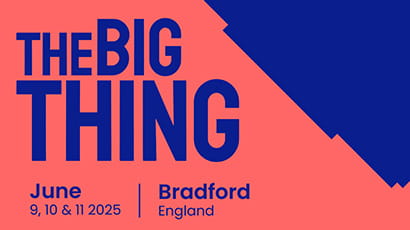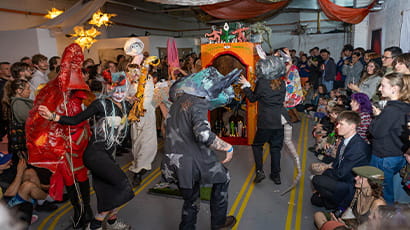Experimental artwork explores biological connection between humans and machines

Emotion recognition is the process of identifying human emotion. People vary widely in their accuracy at recognising the emotions of others. Emotion tracking using technology is a nascent research area with enormous potential.
Rod Dickinson, Senior Lecturer in Digital Media at UWE Bristol, and Brain Computer Interface (BCI) researcher Nathan Semertzidis of Monash University in Melbourne, Australia, worked together to create an extraordinary new artwork and technology experiment, ‘Machine_in_the_middle’, starring World Snooker Champion Steve Davis.
Davis was famous for his deadpan demeanour, never openly expressing any emotion during snooker tournaments and thus earning himself the nickname ‘The Romford Robot’.
In ‘Machine_in_the_middle’, Dickinson and Semertzidis use a BCI headset to stream Davis’ EEG (brainwaves) to an AI that assesses Davis’ emotional state, and then, using Electrical Muscle Stimulation (EMS) the machine animates his face into the expression that it thinks he is experiencing.
Dickinson and Semertzidis’ artwork is based on a well-known type of cyber-attack known as a ‘machine (or man) in the middle’ attack. Usually a “machine (or man)-in-the-middle” attack involves an attacker who secretly intercepts the electronic communication between two parties.
In this case the two parties are the brain and the body of a single person, Steve Davis, and the ‘’machine-in-the-middle’, is the system controlling the communication between Davis' brain and his facial expression.
Rod Dickinson said: “The technology physically manipulates his facial features so it matches the emotion he is experiencing – in effect forcing him so show his emotions.”
The film of Davis was launched at the ‘Decoding Humans: The Quantification of Emotions’ seminar on 30 June.
Related news

12 December 2025
Arnolfini appoints Professor Paul Gough as new Chair of Trustees
Arnolfini, partner organisation of UWE Bristol, has appointed Professor Paul Gough as its new Chair of Trustees.

13 November 2025
Bristol’s screen industry experiences “boom-and-bust cycle” after post-pandemic recovery, new research from UWE Bristol finds
New research from UWE Bristol provides detailed insight into Bristol's screen sector.

30 October 2025
Lecturer shortlisted for prestigious European photography award
Dr Amak Mahmoodian, senior lecturer in photography at UWE Bristol, has been shortlisted for the Deutsche Börse Photography Foundation Prize 2026.

27 October 2025
Graduate wins second industry award for breakthrough film
Tatiana McCabe has won a Wildscreen Panda Award for her documentary which follows a local hero protecting coastal wildlife in Uruguay.

02 October 2025
Documentary by UWE Bristol graduate airs on national television
Hannah Tyson, a UWE Bristol MA Filmmaking graduate, is celebrating the broadcast of her documentary ‘Jazzy’s MMA Dream’, which has aired on CBBC.

11 September 2025
New study to investigate augmented reality as an intervention for emotionally based school avoidance
A UWE Bristol researcher will support a new study exploring whether an augmented reality board game can help young people with emotionally based school avoidance (EBSA).

26 August 2025
UWE Bristol MA students present Showcase at Spike Island
Students from MA Fine Art, MA Graphic Arts, and MA Multi-Disciplinary Printmaking will exhibit their work at the Showcase MA Degree Show, from 4 September.

23 May 2025
Academics feature in documentary exploring the rebirth of Bristol's iconic Megascreen
Professor Mark Bould and Professor Charlotte Crofts are featured in a new documentary about the fascinating journey of the former Bristol IMAX cinema.

21 May 2025
Students reveal creative responses to real-world experiences at UWE Bristol Showcase
UWE Bristol’s Showcase, celebrating student creativity and innovation across the College of Arts, Technology and Environment, returns this June.

19 May 2025
The Big Thing, a landmark event for immersive artists in the UK, comes to Bradford
Immersive Arts will launch its first major event this June in Bradford, the UK’s City of Culture, to bring together the country’s immersive arts community.

17 April 2025
UWE Bristol art students showcase work at Spike Island Open Studios
Spike Island – the home to UWE Bristol’s BA and MA Fine Art courses - opens its doors for the annual Open Studios on 2 May.

16 April 2025
More than 80 UK projects receive nearly £1.2 million in first Immersive Arts funding round
Almost £1.2 million has been allocated to 83 artist-led projects across the UK.






